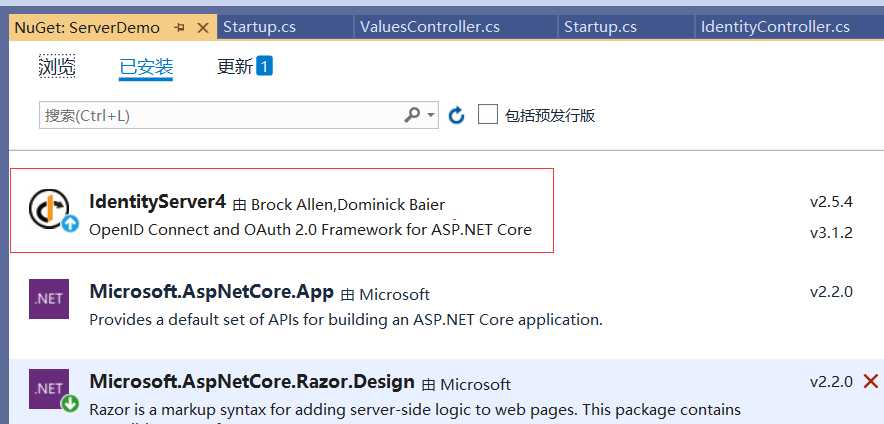今天跟大家分享的是第一种模式,客户端模式
上一章我们讲过,客户端模式是跟用户无关的,只是通过获取token,得到授权,进而请求API资源而已。
下面我们就详细讲述,如何实现客户端模式。
在这里,我们需要新建3个项目,身份认证的服务端、Api资源站、客户端。
以下项目均在Net Core上开发。
一、身份认证服务端
我们新建一个ASP.NET Core MVC项目,命名 ServerDemo
从nuget上,引入IdentityServer4的安装包

在根目录下,新建一个配置类 Config.cs
public class Config { //定义身份资源 public static IEnumerable<IdentityResource> GetIdentityResources() { return new List<IdentityResource>() { new IdentityResources.OpenId(), new IdentityResources.Profile(), }; } //定义Api资源 public static IEnumerable<ApiResource>GetApiResources() { return new List<ApiResource> { new ApiResource("api1","测试Api") //定义Api站点的name和显示名称,这个name必须唯一,作为站点资源识别,在Api站点上也需要指定这个name,必须相等,表示请求这个Api站点 }; } //定义客户端授权类型 public static IEnumerable<Client> GetClients() { return new List<Client> { //第一个,客户端模式Client Credentials new Client{ ClientId="CredentialsClient", //客户端Id,必须且唯一 AllowedGrantTypes=GrantTypes.ClientCredentials, //指定为客户端授权模式 ClientSecrets={ new Secret("111111".Sha256()) //自定义密码,客户端请求时,密码传参数,必须与这个密码一致 }, AllowedScopes={ "api1"}//设置允许授权请求的范围,表示这个客户端Id可请求的资源范围,若不在范围内,请求会被拒绝。 }, }; } }
在这个配置类里面,我们定义了3个方法
第一个是身份资源信息,因客户端模式下,与用户无关,所以这个在客户端模式下,没有也没关系,这里只是与其他模式同个项目,写一块了。
第二个是Api资源,主要陈列API站点的name和显示名称,主要是name,必须唯一。
第三个是客户端,陈列所有客户端标识,授权方式、密码和允许请求的资源范围。
接下来,我们需要在Startup.cs文件中进行注入。
public class Startup { public Startup(IConfiguration configuration) { Configuration = configuration; } public IConfiguration Configuration { get; } // This method gets called by the runtime. Use this method to add services to the container. public void ConfigureServices(IServiceCollection services) { services.Configure<CookiePolicyOptions>(options => { // This lambda determines whether user consent for non-essential cookies is needed for a given request. options.CheckConsentNeeded = context => true; options.MinimumSameSitePolicy = SameSiteMode.None; }); //配置IdentityServer4服务 services.AddIdentityServer() .AddDeveloperSigningCredential() //客户端授权时,必须增加这行,不然客户端会出现keyset missing的错误 .AddInMemoryApiResources(Config.GetApiResources()) .AddInMemoryIdentityResources(Config.GetIdentityResources()) .AddInMemoryClients(Config.GetClients()) ; services.AddMvc().SetCompatibilityVersion(CompatibilityVersion.Version_2_2); } // This method gets called by the runtime. Use this method to configure the HTTP request pipeline. public void Configure(IApplicationBuilder app, IHostingEnvironment env) { if (env.IsDevelopment()) { app.UseDeveloperExceptionPage(); } else { app.UseExceptionHandler("/Home/Error"); // The default HSTS value is 30 days. You may want to change this for production scenarios, see https://aka.ms/aspnetcore-hsts. app.UseHsts(); } app.UseHttpsRedirection(); app.UseStaticFiles(); app.UseCookiePolicy(); //使用IdS中间件 app.UseIdentityServer(); app.UseMvc(routes => { routes.MapRoute( name: "default", template: "{controller=Home}/{action=Index}/{id?}"); }); } }
主要是下面2个
//配置IdentityServer4服务 services.AddIdentityServer() .AddDeveloperSigningCredential() //客户端授权时,必须增加这行,不然客户端会出现keyset missing的错误 .AddInMemoryApiResources(Config.GetApiResources()) //加载定义的Api资源 .AddInMemoryIdentityResources(Config.GetIdentityResources())//加载定义的身份资源 .AddInMemoryClients(Config.GetClients())//加载定义的客户端 ;
//使用IdS中间件 app.UseIdentityServer();
自此,我们就完成了服务端的开发。
但有一点需要注意的是AddInMemoryApiResources是存储内存里面的,若是要自定义存储的介质,比如redis、数据库等中间件上,则可以对Memory进行重载定义,再注入即可。

在id4的官网文档上有写,一时找不到哪个页面上,大家自己去找哈,https://identityserver4.readthedocs.io/en/latest/topics/signin.html#cookie-authentication
原文:https://www.cnblogs.com/fei686868/p/12356046.html